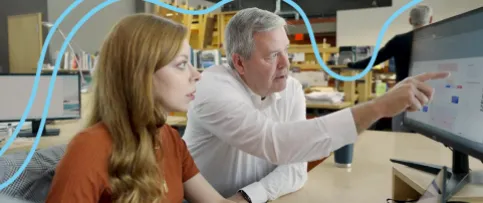Architect and founding principal at Kenzy Architects Sara Yehia, AIA, LEED GA, NCARB, shares her experience as a member of NCARB’s 2019 Re-Think Tank, the steps she took to found her own firm, and advice for other parents entering the field.
When did you know you wanted to pursue architecture as a career?
I’ve wanted to be an architect since I was in middle school. While I was taking a solid geometry class, I looked at the intersecting 3D volumes and started visualizing them as buildings, sketching entrance canopies, windows, and doors on them, and began deciding how many levels they would be. It all came so naturally to me. Of course, I didn’t quite understand at the time what it really meant to be an architect, but I knew it was what I wanted to do. Becoming an architect was a childhood dream that came true.
How did practicing in Egypt help shape the way you approach design in the United States?
I studied architecture at the school of Fine Arts in Cairo, Egypt, and received my Master of Architecture at Arizona State University. I am a registered architect in both Egypt and Arizona, and I have practiced in both. Both settings have allowed me to understand different perspectives and schools of thought, as well as provided me with flexible thinking skills and a deeper understanding of the uniqueness and individuality of people, cultures, companies, and places. Once I began translating these concepts into the design process, I grew both passion and hunger to be inspired by my clients and those occupying the buildings, capturing their unique vision, while also creating a design customized just for them. I thrive in bringing my clients’ visions into reality. My background has also allowed me to develop a deep understanding for context, culture, and sense of place, in all aspects of design.
You were a member of the 2019 Re-Think Tank. What did you gain from that experience?
Being part of the 2019 Re-Think Tank was an exceptional experience. Through the committee, we engaged in several tasks and discussions on valuable subjects like competency in architecture, firm support for licensing candidates, and the future of the profession. We also explored different timelines and paths to licensure and what it could look like in the future. I am so proud to have participated in the creation of the firm support program and document, which I had the honor to help present during the 2019 NCARB Licensing Advisors Summit in Minneapolis. I hope this proposed project moves forward and becomes a catalyst for positive change on how firms can support architectural licensing candidates.
The Re-Think Tank gave me an opportunity to contribute to the advancement of our profession. Most importantly, it gave me and the rest of the committee members a platform to share our experiences and recommendations, while having a voice for change.

Learn About International Licensure
Are you an international applicant? Find out how to pursue your license in the United States with the Foreign Architect Path Manual.
How does having a license make you more marketable?
When I moved from Egypt to the United States, I was an architect (registered overseas) who was no longer able to call herself an architect. Once I became licensed to practice in the United States, it provided me with that missing legitimacy and the ability to once again be called an architect. But it was definitely way more than just a title. Without my license, I wouldn’t have been able to start my own firm. It gave me the ability to stamp drawings and submit for building permits. In addition, being a licensed professional has gained the trust from clients and colleagues, as well as respect from both social and professional networks. Being a licensed architect is an honor and a responsibility. The commitment to serve and maintain the profession’s standard of work has opened a sea of opportunities way beyond my expectations.
We know you founded your own firm (Kenzy Architects) in 2018. What inspired you to take this next step in your career and what are some of its benefits?
Until a few months before I started my own firm, I had never considered doing it. However, I had always wanted to be a partner in an architectural firm, so I began looking at different paths people took to accomplish this, assessing possible benefits and risks, as well as my own skills and capabilities. Most of my experience was in design and construction, but none in business management or development. After all of my assessments, I decided I wanted to be a seller-doer. I wanted to be able to win work and do work.
I followed through with this goal by asking the firm I was working for at the time to allow me to practice business development in addition to my project responsibilities. A few months later, it was clear to me and everyone that I was very successful in this area. At the same time, I was facing many challenges navigating corporate politics. I felt that the diversity of my skills and wide range of capabilities were making it hard for me to fit into any corporate molds or tracks.
That’s when I started considering creating my own firm. So, I did another risk assessment exercise and compared the risks of trying to start my own firm versus those of becoming a partner at a firm, and they seemed almost equal. However, the potential benefits of starting my own firm were far more promising. It became clear to me that I have what it takes to define my own architectural practice and found my own firm.
In October 2018, I founded Kenzy Architects, and it has been a great journey since then. I appreciate the ability to march to my own beat and execute my vision, while thriving to create work environments where any team can do the same.
My son had stood in front of his whole class and said, “I saw the virtue of perseverance in my mom when she was studying for a big architectural exam.” I had never felt more successful, or more proud of myself, as much as I felt when hearing this.
What advice do you have for other parents entering the field?
When I was halfway through with my licensing exams, my son was seven years old. I’d wake up at 4 a.m. to study before going to work because the evenings were too busy and the days were so long, it was impossible to get any information in my brain at the end of the day. Because of this, my son would complain about how busy I was. Eventually, I failed one of the exams. I took it again and failed, again. My son was upset, and I received a “What? You failed again?” comment with an added eye roll and an emphasis on the word “again.” It was not the best feeling, but it’s really hard to teach a seven-year-old to be supportive, especially when they just want to spend time with their parents. I felt terrible and began having doubts about whether or not I was prioritizing my life correctly until I received an email from my son’s teacher expressing that she wanted to share something that had happened in class. His teacher had asked the students to share a virtue they saw in each other. My son had stood in front of his whole class and said, “I saw the virtue of perseverance in my mom when she was studying for a big architectural exam.” I had never felt more successful, or more proud of myself, as much as I felt when hearing this.
I advise other parents to be persistent and consistent in their efforts to pursue their dreams and never give up or let the guilt of spending less time with family get in the way because at the end of the day, you are being a role model and teaching your kids how to reach for their own dreams and achieve any goals. Your kids will see it and they will understand, it’s just hard for them to articulate it at such a young age.
Where do you think the future of architecture is headed?
Technology will continue to play a big role in shaping the design and construction industry. Although there are fears regarding artificial intelligence replacing architects, I do believe that the architecture profession will continue to play a major role in the built environment and will never lose its value, but rather, evolve and progress. In the future, artificial intelligence will assist in advancing the profession and be a significant tool that architects can use. These technological advancements will remove many limitations we currently have and enable us to be more creative, explore more options, and use iterative design to reach results we haven’t reached before. They will also create more efficient processes and possibly help reduce liability risks within our profession. We, architects, need to progress and evolve not only in embracing the development of technology, but in taking an active part in reshaping our profession to ensure we provide a better built environment for the world.


